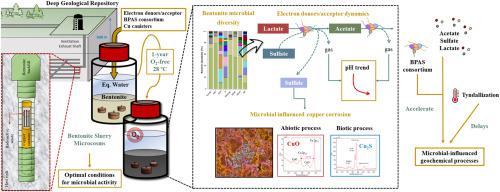当前位置:
X-MOL 学术
›
Environ. Pollut.
›
论文详情
Our official English website, www.x-mol.net, welcomes your feedback! (Note: you will need to create a separate account there.)
Microbial influence in Spanish bentonite slurry microcosms: Unveiling a-year long geochemical evolution and early-stage copper corrosion related to nuclear waste repositories
Environmental Pollution ( IF 7.6 ) Pub Date : 2024-07-02 , DOI: 10.1016/j.envpol.2024.124491 Marcos F. Martinez-Moreno , Cristina Povedano-Priego , Mar Morales-Hidalgo , Adam D. Mumford , Elisabet Aranda , Ramiro Vilchez-Vargas , Fadwa Jroundi , Jesus J. Ojeda , Mohamed L. Merroun
Environmental Pollution ( IF 7.6 ) Pub Date : 2024-07-02 , DOI: 10.1016/j.envpol.2024.124491 Marcos F. Martinez-Moreno , Cristina Povedano-Priego , Mar Morales-Hidalgo , Adam D. Mumford , Elisabet Aranda , Ramiro Vilchez-Vargas , Fadwa Jroundi , Jesus J. Ojeda , Mohamed L. Merroun

|
The deep geological repository (DGR) concept consists of storing radioactive waste in metal canisters, surrounded by compacted bentonite, and placed deeply into a geological formation. Here, bentonite slurry microcosms with copper canisters, inoculated with bacterial consortium and amended with acetate, lactate and sulfate were set up to investigate their geochemical evolution over a year under anoxic conditions. The impact of microbial communities on the corrosion of the copper canisters in an early-stage (45 days) was also assessed. The amended bacterial consortium and electron donors/acceptor accelerated the microbial activity, while the heat-shocked process had a retarding effect. The microbial communities partially oxidize lactate to acetate, which is subsequently consumed when the lactate is depleted. Early-stage microbial communities showed that the bacterial consortium reduced microbial diversity with and dominating the community. However, sulfate-reducing bacteria such as , , and were enriched coupling oxidation of lactate/acetate with reduction of sulfates. The generated biogenic sulfides, which could mediate the conversion of copper oxides (possibly formed by trapped oxygen molecules on the bentonite or driven by the reduction of HO) to copper sulfide (CuS), were identified by X-ray photoelectron spectroscopy (XPS). Overall, these findings shed light on the ideal geochemical conditions that would affect the stability of DGR barriers, emphasizing the impact of the SRB on the corrosion of the metal canisters, the gas generation, and the interaction with components of the bentonite.
中文翻译:

微生物对西班牙膨润土浆料微观世界的影响:揭示与核废料储存库相关的长达一年的地球化学演化和早期铜腐蚀
深层地质处置库 (DGR) 概念包括将放射性废物储存在金属罐中,周围用压实膨润土包围,并深入地质构造中。在这里,建立了带有铜罐的膨润土浆料微观世界,接种了细菌聚生体并用乙酸盐、乳酸盐和硫酸盐进行了修正,以研究它们在缺氧条件下一年的地球化学演化。还评估了早期(45 天)微生物群落对铜罐腐蚀的影响。修改后的细菌群落和电子供体/受体加速了微生物活性,而热休克过程则具有延缓作用。微生物群落将乳酸部分氧化成乙酸盐,随后当乳酸耗尽时乙酸盐被消耗。早期微生物群落表明,细菌群落减少了微生物多样性,并主导了群落。然而,硫酸盐还原菌如 、 、 和 则富集了乳酸/乙酸盐的氧化与硫酸盐的还原。通过 X 射线光电子能谱 (XPS) 鉴定了生成的生物硫化物,它可以介导铜氧化物(可能由膨润土上捕获的氧分子形成或由 H2O 还原驱动)转化为硫化铜 (CuS)。总的来说,这些发现揭示了影响 DGR 屏障稳定性的理想地球化学条件,强调了 SRB 对金属罐腐蚀、气体产生以及与膨润土成分相互作用的影响。
更新日期:2024-07-02
中文翻译:

微生物对西班牙膨润土浆料微观世界的影响:揭示与核废料储存库相关的长达一年的地球化学演化和早期铜腐蚀
深层地质处置库 (DGR) 概念包括将放射性废物储存在金属罐中,周围用压实膨润土包围,并深入地质构造中。在这里,建立了带有铜罐的膨润土浆料微观世界,接种了细菌聚生体并用乙酸盐、乳酸盐和硫酸盐进行了修正,以研究它们在缺氧条件下一年的地球化学演化。还评估了早期(45 天)微生物群落对铜罐腐蚀的影响。修改后的细菌群落和电子供体/受体加速了微生物活性,而热休克过程则具有延缓作用。微生物群落将乳酸部分氧化成乙酸盐,随后当乳酸耗尽时乙酸盐被消耗。早期微生物群落表明,细菌群落减少了微生物多样性,并主导了群落。然而,硫酸盐还原菌如 、 、 和 则富集了乳酸/乙酸盐的氧化与硫酸盐的还原。通过 X 射线光电子能谱 (XPS) 鉴定了生成的生物硫化物,它可以介导铜氧化物(可能由膨润土上捕获的氧分子形成或由 H2O 还原驱动)转化为硫化铜 (CuS)。总的来说,这些发现揭示了影响 DGR 屏障稳定性的理想地球化学条件,强调了 SRB 对金属罐腐蚀、气体产生以及与膨润土成分相互作用的影响。











































 京公网安备 11010802027423号
京公网安备 11010802027423号